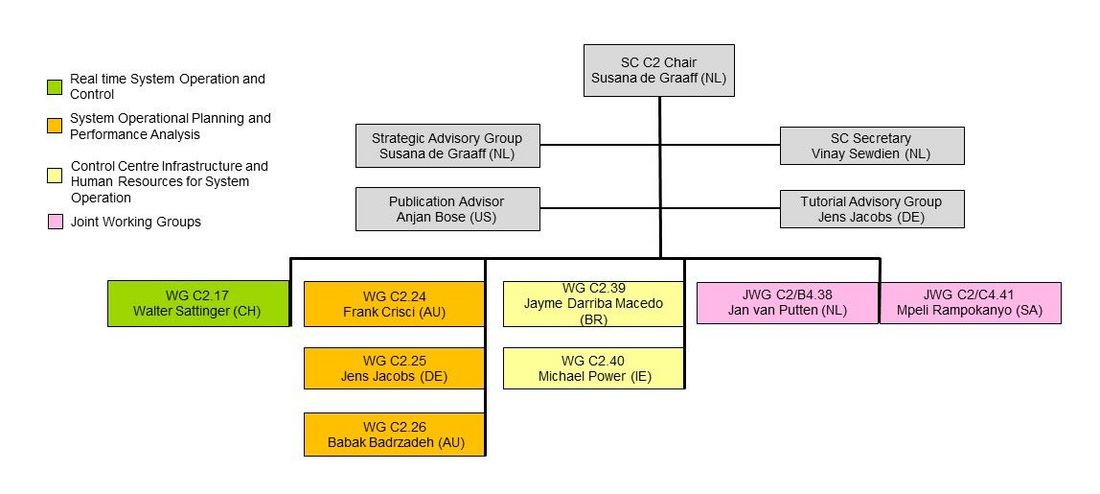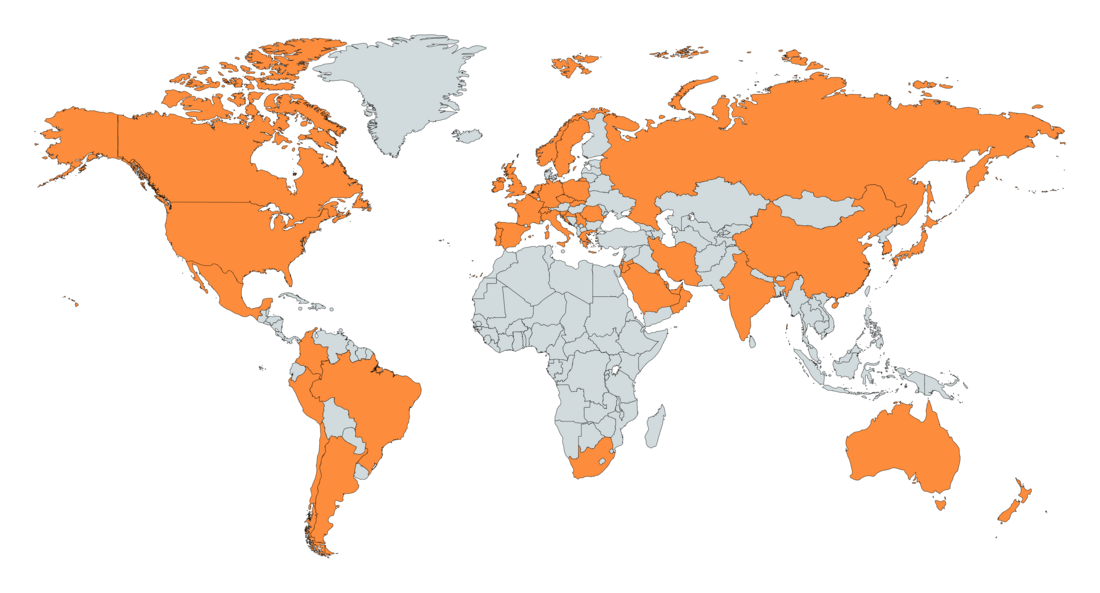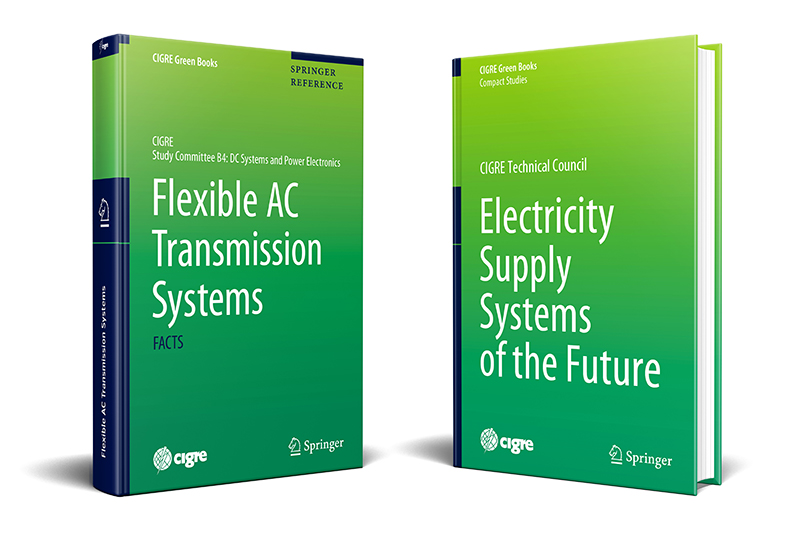Power system operations and control
by Dr. Susana Almeida de Graaff, Chair & Vinay Sewdien, Secretary
Introduction
Electrical power systems keep on increasing the level of renewable energy sources (RES) penetration, while the environmental and political goals are driving a discussion of energy system integration by coupling different energy sectors. There are initiatives to produce green hydrogen from RES, resulting in decreasing CO2 emissions and an increase of the available flexibility in the network. Distribution systems are becoming producers and flexibility providers, making information exchange and coordination crucial to keep the system security of supply. In 2019, during the Climate Action Summit the EU succeeded to call the attention of world leaders, from government, the private sector and civil society, on the urgency for action to address the climate emergency, and on increasing climate action with concrete, realistic plans in line with reducing greenhouse gas emissions by 45 per cent over the next decade, and to net zero emissions by 2050. This brings enormous challenges to power systems, and consequently, for system operators that need to keep the lights on with the same level of reliability as we have today. Therefore it is important to develop innovative concepts, methods and technology for system operations, increasing not only the observability but also the controllability and intelligence of the power system. System restoration and system resilience enhancement are part of current activities, to be able to recover and restore the system adequacy when facing high impact and low probability events, which seems have become more likely with global warming.
With the increasing complexity of the power system, which is becoming more dynamic and volatile, system operators need to develop new tools, new training philosophies, including power system dynamics and stability analysis, in order to increase the knowledge and skills of their staff. System operators need to be prepared to operate a low-carbon power system now and in the future, and SC C2 is engaged in supporting system operators with this challenging task. In addition, when reflecting on the abovementioned challenges and looking at the focus of the current activities of SC C2, we recognise a trend of knowledge integration, where the cooperation and sharing knowledge among CIGRE SCs is becoming essential to correctly address the complexity that we are facing.
In the end of 2019, beginning of 2020, system operators were confronted with a worldwide pandemic with a major socio-economic impact, especially after the beginning of March when the extraordinary containment measures were taken by Member State governments. All TSOs have as one of the main priorities to keep their personnel safe and healthy, especially control room operators and field personnel, in addition with their permanent goal of ensuring security of supply. Power systems seem to be operating in a secure manner during this pandemic period. There was an impact on the load magnitude and shape in some more than others depending on the extension of the confinement measures, but Covid-19 extraordinary measures may not be the sole factor responsible for the load decrease. Weather conditions, especially solar irradiation, also play a role, boosting the electricity generation of RES. SC C2 is starting initiatives to capture the Covid-19 impact world-wide.
SC C2 Mission and scope
The scope of the SC C2 covers the technical, human resource and institutional aspects and conditions for a secure and economic system operation of power systems in a way that is in compliance with requirements for network security, against system disintegration, equipment damages and human injuries, and security of electricity supply.
Unbiased and high-quality knowledge dissemination to the power systems community by CIGRE Study Committees is a strong pillar for the development and performance of power systems, especially in the increasingly integrated environment. This applies not only to current but also to future power systems. SC C2 therefore needs to understand, use and integrate results from other Study Committees to assure that technical concepts can be applied in real-time in various contexts and implemented by the System Operators. An area which is unique for C2 is however the dependence on good performance of human resources in performing operational planning and real-time system operation. In these respects SC C2 embraces a wide range of competence areas and interfaces to other disciplines.
The mission of SC C2 can be summarised in the following four points:
- To facilitate and promote knowledge dissemination and worldwide collaboration in the field of system operation and control, providing adequate conditions for progress of engineering.
- To facilitate unbiased technical information exchange, integrating solutions and recommendations for system operations issues and problems. These first two points are achieved among others by the publication of Technical Brochures and papers, delivering tutorials, and participating in conferences, symposia and colloquia.
- To prepare for the foreseen future challenges by integrating and consolidating available knowledge, and taking into account the usage of new and proven technologies. For example, the joint effort of several Study Committees in establishing Joint Working Groups, where different expertise and knowledge is combined, as well as in writing multi-disciplinary Reference Papers.
- To engage and encourage young members in order to increase their involvement in the SC activities. By integrating them into Working Groups, a bridge between the young experts and experienced members can be built. SC C2 aims to connect, when possible, a young member to a mentor from the same SC and NC. This gives the opportunity to support the young member's development in a supervised way.
Structure
An overview of the structure of SC C2 is given in Figure 1. The SC has 27 regular members (incl. 3 from distribution) and 15 observer members, 8 active Working Groups of which 2 are Joint Working Groups with other CIGRE SCs, and 3 Advisory Groups.
The Strategic Advisory Group, consisting of the SC Chair, Secretary and other SC C2 experts, deals with SC strategy and updates the scope of the Technical Directions. The Publication Advisory Group is responsible for the revision of synopses and papers for CIGRE activities where SC C2 plays a role. The Tutorial Advisory Group (TAG) coordinates the development, planning, quality assurance and delivery of tutorials for conferences, symposia, colloquia and webinars. There are around 170 experts from 39 countries actively involved in SC C2 activities.

Figure 1 - SC C2 Structure
Figure 2 gives an overview of the geographical distribution of SC C2 members.

Figure 2 - Geographical distribution of SC C2 members
Main technical directions
SC C2 has defined three Technical Directions (TD) to address important emerging factors that will influence and define new requirements on the System Operation performance.
TD 1: Real-time System Operation and Control
- Wide area control, supervision and increased coordination: integration of regional and national grids into large control areas
- Operation and control of new technologies and system protection schemes
- Increased power system controllability, observability, flexibility and exchange of information, both at transmission and distribution level: e.g. voltage control, frequency control
- Interaction between market mechanisms and power system operation, e.g. ancillary services and congestion management
- Operational real-time security and risk assessment
- Maintaining Security of Supply, Emergency control and restoration procedures and tools
- Information and data exchange in real-time operation
The Working Groups C2.17 and C2/B4.38 address topics in this TD 1.
TD 2: System Operational Planning and Performance Analysis
- Impact on system operation from new generation mix, storage and changes in electrical load behaviour
- Close to real-time operation, crucial for a successful and secure real-time operation, performed both by operational planners and control room operators
- Security assessment in Operational Planning, including coordinated activities
- Assessment of monitoring, control and protection functionalities, including development of new operational strategies
- Emerging Operational Issues for Transmission and Distribution Interaction
- Impact assessment on integration of new technologies
- Blackout integral analysis, defence plans, resilience schemes and restoration strategy considering the evolving environment
- Reliability, network security principles and generation and transmission adequacy
- Operational requirements in Grid Codes
- Information and data exchange in the operational planning timeframes
The Working Groups C2.24, C2.25, C2.26 and C2/C4.41 address topics in this TD 2.
TD 3: Control Centre Infrastructure and Human Resources for System Operation
- Knowledge management and Operator training
- Operator training simulator and other training tools
- Control Centres processes, methods, tools and organisation development
- Tools for decision support and situational awareness
- Integration and exchange of information in system operations and data management
- EMS/SCADA systems, specifications and experiences
- WAMS system requirements and their integration within CC
- Control Centre reliability and resilience
- Information, cyber-security and other vulnerability aspects on control centres
The Working Groups C2.39 and C2.40 address topics in TD 3.
However, it is relevant to point out that some of the WGs actually touch upon more than one technical direction.
Working Groups Report
Below a short update of the Working Groups active in 2019-2020 is provided.
WG C2.17 Wide Area Monitoring Systems - Support for Control Room Applications
The Working Group will restart to draft an additional Technical Brochure, which will continue the work already published in TB 750 by going one step forward in extending the monitoring to system protection and control. Therefore, after identifying the current experience and control room practice it is planned to describe a flexible and scalable system architecture, identity possibilities for standardisation in event recording and analysis. Further on the process of WAMPAC implementation up to recommendations for control room measures will be addressed. Possibilities for the use of PMUs for special protection schemes (SIPS) and usage for interactions with HVDC links or inverter-based generation will be addressed as well.
WG C2.24 Mitigating the risk of fire starts and the consequences of fires near overhead lines for system operations
The WG C2.24 is made up of representatives utility representatives, consultants and academics, from 10 countries. The substantive work of the group has been in completion of a survey of transmission and distribution utilities on wildfire (bushfire) risk management practices. The group received 24 responses, some of which are from utilities with both transmission and distribution assets. Of these, 16 utility responses will be used to produce the Technical Brochure. Topics to be included in the brochure include wildfire modelling, technologies for wildfire risk mitigation, classification of wildfire risk areas and coordination of utilities with emergency services (first responders). The TB is expected in Q1-2021.
WG C2.25 Operating strategies and preparedness for system operational resilience
The Working Group was approved in June 2018. In the meantime WG members are working in different work streams on the common understanding of operational resilience as well as identifying the most relevant high impact low frequency (HILF) events. In 2019, WG C2.25 performed a survey collecting information in relation to system operational resilience. 38 responses were received and analysed. The information will be included in the further work and provide relevant information for the TB. A short follow-up questionnaire is planned for summer 2020. As an outcome of the survey and as next steps a list of conditions and the associated operating strategies and procedures that have been developed to help system operators to systematically manage and restore disrupted systems to their normal or pre-disturbed state will be prepared. A CSE paper providing first glance on the WG findings was published in June 2020. The final aim of this WG is to identify and provide possibilities to enhance and improve current existing operational resilience. The TB is expected in Q1-2021.
WG C2.26 Power system restoration accounting for a rapidly changing power system and generation mix
This Working Group, approved in March 2019, aims to identify and manage emerging risks on system restoration, investigate opportunities for increased utilisation of new and emerging technologies during system restoration, and enable system operators and network owners to continue to execute a successful system restart when required despite the rapidly changing generation mix. The work carried out so far in this WG includes discussion on system restoration practices and challenges in more than 10 countries from those represented in the WG, the role of inverter-based resources in system restoration either as a black starter or to support system restoration, tools and techniques for analysing system restoration including real-time and offline electromagnetic transient simulation and fast decision support tools, and physical testing demonstrating the capability of VSC HVDC during restoration. Emerging areas recently started include system restoration subject to cyber-security, loss of control centres, and pandemic situations. Other immediate areas of work include power system modelling and physical testing to better understand the roles and limitations of various types of inverter-based resources during system restoration. The TB is planned to be published in Q4 2021, however, a delay of up to a maximum of six month may occur due to the impact of COVID-19. The TB is planned to be published in Q4 2021.
WG C2.39 Operator Training in Electricity Grids at Different Control Levels and for Different Participants/Actors in the New Environment
The Working Group started its work in August 2018. A first task was based on a basic five-item questionnaire answered by all members of the group, whose analyses and conclusions resulted in Document No.1 that clarifies the existing situation on the topic based on the scenarios presented by the 16 companies surveyed. This document has its final version ready by the end of 2019. During the preparation of this document, the group chose 9 items that were considered important for further details on training based on simulator exercises, including the processes and resources available and to be developed. These 9 items generated a new questionnaire answered by the group members. The responses received will be available to members and the new material that will complete the final Technical Brochure will be prepared. The TB is expected in Q1-2021.
WG C2.40 TSO-DSO Co-Operation – Control Centre Tools Requirements
The paradigm shift in the configuration of the power system with a high penetration of distributed renewable generation connected at the DSO level creates a new dimension in TSO-DSO coordination practices and procedures. The role of this WG, approved in June 2018, is to specify a set of control centre tools and related IT platforms for both the TSO and DSO to manage and operate this newly evolved power system. A critical aspect that must be addressed is that the tools must enable a high level of cooperation between the TSO and DSO. Interoperability between the tools should be developed taking into account different time-horizons (at least real-time and short-term operational planning) and different services. The Working Group will publish its first paper at the next Paris session. The Working Group has 25 experts from 12 different countries and expects to publish its TB in Q4-2020.
JWG C2/B4.38 Capabilities and requirements definition for Power Electronics based technology for secure and efficient system operation and control
The JWG worked in two parallel streams, one to identify the operational challenges that are expected with increasing levels of power electronics and one preparing an overview of the capabilities of power electronic devices. The JWG published its finding on the operational challenges in the CSE Journal, Volume 17. Next, the JWG made a mapping of the capabilities of the power electronics that can help to solve some of the challenges. The focus was then shifted to develop an overview of examples and best practices, while the last part will describe how to prepare system operations for the expected large amounts of power electronics interfaced devices. Doing this, the synergy between the system operation experts and the power electronics technology experts in the JWG showed to be very beneficial. The TB is planned to be published in Q4-2020.
JWG C2/C4.41 Impact of high penetration of inverter-based generation on system inertia of networks
The rapid increase in integration of renewable generation globally has led to concerns around the depletion of power system inertia more especially when large fleets of static renewable generation displaces the conventional synchronous generation. The objective of this JWG is to study the impact of depleting power system inertia and to advice and formulate philosophies for system operations in order to prepare for the ongoing energy transition. This JWG has produced two papers to date and has conducted a survey about industry experience on FCR, FFR requirements and minimum inertia levels. The JWG comprises 31 experts from 17 countries. The TB is planned to be published in December 2020 and a webinar is scheduled around the same time. Overall TB progress to date is at around 75%. The TB is planned to be published in Q4-2020.

CIGRE active Working Groups / Call for experts
Past Tutorials & Webinars
During the Aalborg Symposium, a tutorial was delivered on behalf of SC C2 on Tuesday 4 June 2019. During the tutorial the main results of the work conducted under Working Group C2.17 "Wide Area Monitoring Systems - Support for Control Room Applications" was presented.
Furthermore, on 5 September 2019, the first webinar of SC C2 was organized. In this webinar, the main contents of the Technical Brochure (TB) 742 was presented. This TB sets forth a systematic basis for the classification, integration and coordination of stability control from a global perspective. The proposed framework integrates preventive, event-based, response-based, restorative controls with online DSA to enhance control adaptability and coordination. The webinar is available free of charge on e-cigre:
Joint Technical Activities
The SC also participates in other Working Groups that are being led by other SCs. SC C2 is part of Joint Working Groups C6/C2.34 and D2/C2.48 and C4/C2.58/IEEE. The SC has active liaisons in the Working Groups A1.65, C5.27, C1/C4.36, C6.36 and C6.40.
Reference Paper
The electric power system industry is becoming increasingly aware of the potential adverse impact of extreme events and physical and cybersecurity attacks on the power system operations. The High Impact, Low Frequency events and increased frequency of system disturbances caused by natural phenomena results in a shift of focus of the energy industry from purely developing preventive measures, towards providing and enhancing resilience of the power system. Working Group C2.25 produced a Reference Paper titled “Power System Operational Resilience – What It Means and Where We Stand”, in which a framework for quantifying resiliency is introduced, which captures the step by step assessment of resiliency in the process to achieve a desired strategy. The Reference Paper is published on e-cigre, available for free:
Green Books
SC C2 contributed to two Green Books. For the Green Book "FACTS" of SC B4, SC C2 contributed with a chapter on the operational practices of FACTS devices. Furthermore, SC C2 wrote a chapter for the Green Book on Future Power Systems. In this chapter, an overview is given of the current state of the art, including implemented processes in the system operation time frame (capacity calculation, security analysis, coordination, operator training, etc.), as well as expected operational challenges, trends and solutions to address these challenges.
Both Green Books are expected to be published in August 2020.

The Green Books are available for purchase on our partner's website Springer.
If you are a CIGRE Member, please contact us to benefit from a 40% discount on your purchase.
Publications
The following publications have been made since August 2019 as a result of work carried out by SC C2 Working Groups:
JWG C2/B4.38 is finalizing its Technical Brochure, to be published in Q4-2020. The WGs C2.24, C2.25, C2.39, C2.40 and C2/C4.41 are also finalising their Technical Brochures for publication in Q1-2021.
Awards
The following SC C2 members received CIGRE Awards in 2020:
- Paulo Gomez (Brasil) was awarded the CIGRE Fellow Award;
- Susana de Graaff (Netherlands) and Ole Gjerde (Norway) were awarded the Honorary Member Award;
- Renuka Chatterjee (USA) was awarded the 2020 Technical Council Award;
- Enrico Carlini (Italy) and Rick Spyker (Canada) were awarded the Distinguished Member Award.
Workshops, Conferences and Seminars
From August 2019 onwards, the following SC C2 members took part in events:
- Jan van Putten, convener of JWG C2/B4.38, delivered a keynote speech on 5 December 2019 during the IEEE workshop on Representation of Power Electronics for Grid Dynamics in London;
- Vinay Sewdien, Technical Secretary of SC C2, delivered a keynote speech on system operational challenges due to the energy transition for CIGRE Colombia on 13 March 2020;
- Walter Sattinger, convener of WG C2.17, together with several WG members had planned presentations during a Joint CIGRE SC C2/IEEE WAMS workshop in Arnhem on 18 May 2020. However, due to the COVID-19 pandemic, this workshop is postponed until further notice.
Future Activities
The next events for SC C2 are:
- 2020 CIGRE e-Session: The Large Disturbances Workshop, organised jointly with SC C5, will take place on Monday 24 August 2020. The following presentations are confirmed for the workshop:
| Topic | Region |
| UK power cut (9/8/2019) – SO & Market aspects | UK |
| Day ahead market coupling failure in Europe (7/9/2019 and 4/2/2020) – SO & Market aspects | Europe |
| Blackout Argentina (16/6/2019) | Argentina |
| Hokkaido whole area blackout in September 2018 | Japan |
| Proliferation of shale gas in the US | USA |
| August 2018 System Separation Events in Australia – SO & Market Aspects | Australia |
| Massive System Imbalance Situations in Germany in June 2019 – SO & Market Aspects | Germany |
- Giorgio Giannuzzi and Cosimo Pisani will give a tutorial, titled “Wide Area Monitoring – Control Room Applications”, planned for 24 November 2020 during the CIGRE South East European Regional Council conference in Vienna.
- A Webinar of JWG C2/B4.38 is planned for Thursday 29 October 2020. During the webinar operational challenges due to the energy transition will be presented. Then, insights will be given in the technical capabilities of and requirements for the integration of power electronics based devices in the power system, with the focus on the usage of these technologies for system operation. The participation in the webinar is free of charge, but registration is compulsory;
- A Webinar of JWG C2/C4.41 is planned for Thursday 10 December 2020. During the webinar the presenters will discuss the impact of inverter-based generation on system inertia. The participation is free of charge, but registration is compulsory.
Incoming Team
After the 2020 CIGRE Session, Jayme Darriba Macedo (jayme(@)ons.org.br) and Flavio Alves (frma(@)cepel.br) will take office as the next Chair, respectively Technical Secretary of SC C2.
Conclusions
In the future the integration of energy system will have an impact on system operations, and SC C2 will undoubtedly contribute to the developments of the future power system. System operation is at the heart of the power system and has a crucial role in "keeping the lights on". This is reflected by all the activities and active Working Groups in the Study Committee. As well as by welcoming and integrating distribution system operators, and in the more integrated and increased cooperation with other SCs, facilitating multi-disciplinary discussions, and opening the potential to provide excellent contributions to the CIGRE community.
I would like to say that the four years in the driving seat of SC C2 have been a very rich and rewarding personal experience that I take in my heart. I would also like to acknowledge and thank with gratitude the active participation and support of all dedicated individuals that contributed to the above mentioned achievements, respectively Vinay Sewdien, all convenors, advisors, and members. I believe we have and will continue to make a real difference by improving and developing system operations further. Finally, I extend my best wishes to Jayme Darriba Macedo and Flavio Alves, as respectively the incoming Chair and Technical Secretary of SC C2.
